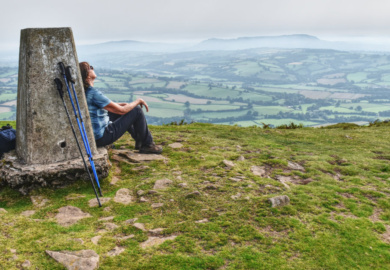The Coleridge Way runs for 51 miles between Nether Stowey in Somerset and Lynmouth in Devon. To walk it is to follow in the footsteps of Coleridge, one of the greatest of the Romantic poets, who spent much of his life walking these hills and moors, drawing inspiration from the landscape and its weather.
The Poet
Samuel Taylor Coleridge was born in October 1772 in Ottery St Mary in Devon. A brilliant scholar, he went to Jesus College, Cambridge but when there, spent his time and money on wine, opium, and prostitutes, ending up heavily in debt. Around this time, he started walking and set out on foot with a fellow undergraduate to explore Wales. Stopping at Oxford en route, he met Robert Southey with whom he became good friends.
Dropping out of Cambridge, Coleridge went to live with Robert Southey in Bristol where he met and later married Southey’s fiancée’s sister, Sara. Failing to earn a living from his poetry, in 1796 he moved Sara and their son to Nether Stowey where Thomas Poole, owner of a tannery who admired Coleridge’s writing and supported his political views, gave them a rent-free house, and paid off their debts. Not long after, Coleridge met Wordsworth and his sister, Dorothy, and the two families became great friends.
In 1799 Coleridge met and fell in love with Sara Hutchinson. Leaving his family, he moved to Keswick in the Lake District. Now heavily addicted to opium, he spent the final 18 years of his life as a patient of Doctor James Gillman in Highgate and died there in July 1834 at the age of 61. He is buried in the aisle of St. Michael’s Parish Church in Highgate.
Following in the footsteps of the poet on The Coleridge Way
Running east to west, The Coleridge Way begins at Coleridge Cottage in Nether Stowey, the house which Tom Poole gave to Coleridge rent-free and where he lived with his family for 3 years from 1796 to 1799. While he was living in this cottage, Coleridge wrote his most influential and finest work, including The Rime of the Ancient Mariner, Kubla Khan and Christabel. The cottage is now owned by The National Trust (open Wed-Sun, 1100 – 1700, £7.50pp).
Traversing the Quantock and Brendon Hills to Porlock before crossing Exmoor National Park to the coast at Lynmouth, The Coleridge Way takes you through landscapes frequented by Coleridge and his walking companion, Wordsworth. While living in Nether Stowey and taking almost daily walks in the Quantocks, Coleridge developed a sense of nature as an animated life force, a sort of benevolent companion, a notion which became one of the cornerstones of the Romantic movement. A great observer of weather, the squalls, mists and play of light on water drew Coleridge to Exmoor, and its singular landscape features appear (albeit under a pseudonym) in his works.
In October 1797, seeking the solitude he needed to finish Osorio, the play he was writing, Coleridge walked to Porlock and then followed a difficult zig-zag path from Porlock Weir to Culbone which, at that time, was considered one of Somerset’s holy places. Despite being set in Spain, one passage in the play clearly describes the woodlands of Culbone. It was during his stay at Culbone that Coleridge took opium and, in the resulting trance, composed 200-300 lines of poetry which he later refined into Kubla Khan.
Shortly after his first visit, Coleridge set out with William Wordsworth and his siter, Dorothy, to show them the path to Culbone and the three of them walked beyond Culbone to Lynmouth. The following day they went on to the Valley of Rocks where they jointly decided to write The Wanderings of Cain, set in the valley. The story was never finished. Although The Coleridge Way officially ends in Lynmouth, you can follow the South West Coast path onwards to the Valley of the Rocks.
A week later Coleridge and Wordsworth set out again, this time for Exmoor, and inspired by the landscape, resolved to jointly write a poem to fund the outing. The resultant poem – The Rime of the Ancient Mariner – took Coleridge 5 months to complete with much of the plot coming from Wordsworth. The harbour from which the mariner sets sail is undoubtably Watchet where they stayed, and the hermit’s woodland home is Culbone.
The Coleridge Way
Waymarked (appropriately) with a quill motif, you can either follow the route west to east (Lynmouth to Nether Stowey, or east to west, beginning in Nether Stowey and ending in Lynmouth. Equally well, you can dip in and out of the route by following sections on day walks. We walked from Webbers Post to Porlock Weir mainly along The Coleridge Way and it featured all sorts of goodies, from ancient oak woods and Exmoor National Park to the delightful Porlock Weir.
The full route crosses varied landscapes from open moorland and purple heathland to ancient woodlands and tranquil valleys, all of it studded by picturesque and historic villages such as Horner, Porlock and Lynton. You can leisurely walk the entire 51 miles over 6 consecutive days, staying in B&B accommodation along the way. You can find all the information you need, including route directions and map extracts, on the Visit Exmoor website.





